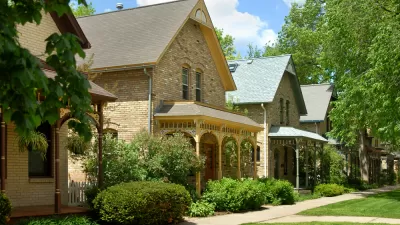A proposal in Snohomish County, Washington could raise the lot coverage limits in medium density residential zones to allow for more usable square footage.

Under revised rules, Snohomish County could allow increased lot coverage and more flexible design in parts of the county's unincorporated urban growth areas. As reported by Stephen Fesler in The Urbanist, "county planners principally hope that the code amendments will solve lot coverage mismatches between zoning types, allow more flexible building and site design, and help development proposals reasonably achieve allowed zoning densities."
Lot coverage dictates how much of a lot can be covered by structures and has a major impact on how much usable square footage a lot can hold. Although sometimes associated with stormwater management and drainage, county planner Janet Wright addressed those concerns, stating in a briefing to the County Council "our drainage codes address mitigating stormwater runoff from…impervious surface areas and our code requires that projects implement low-impact development strategies where feasible." Wright also explained that "the current LDMR lot coverage maximum is unique and inexplicably lower than lower-density residential zones" and that increasing lot coverage "could bring more harmony of development patterns."
While the return on investment will ultimately drive site utilization, proponents of higher lot coverage predict that higher limits will "ensure that more projects fully use allowed zoning densities." The proposal is headed to a public hearing on March 3rd.
FULL STORY: Snohomish County Explores Higher Lot Coverage Allowances in Medium Density Zones for Housing

Study: Maui’s Plan to Convert Vacation Rentals to Long-Term Housing Could Cause Nearly $1 Billion Economic Loss
The plan would reduce visitor accommodation by 25,% resulting in 1,900 jobs lost.

Alabama: Trump Terminates Settlements for Black Communities Harmed By Raw Sewage
Trump deemed the landmark civil rights agreement “illegal DEI and environmental justice policy.”

Why Should We Subsidize Public Transportation?
Many public transit agencies face financial stress due to rising costs, declining fare revenue, and declining subsidies. Transit advocates must provide a strong business case for increasing public transit funding.

Paris Bike Boom Leads to Steep Drop in Air Pollution
The French city’s air quality has improved dramatically in the past 20 years, coinciding with a growth in cycling.

Why Housing Costs More to Build in California Than in Texas
Hard costs like labor and materials combined with ‘soft’ costs such as permitting make building in the San Francisco Bay Area almost three times as costly as in Texas cities.

San Diego County Sees a Rise in Urban Coyotes
San Diego County experiences a rise in urban coyotes, as sightings become prevalent throughout its urban neighbourhoods and surrounding areas.
Urban Design for Planners 1: Software Tools
This six-course series explores essential urban design concepts using open source software and equips planners with the tools they need to participate fully in the urban design process.
Planning for Universal Design
Learn the tools for implementing Universal Design in planning regulations.
Smith Gee Studio
Alamo Area Metropolitan Planning Organization
City of Santa Clarita
Institute for Housing and Urban Development Studies (IHS)
City of Grandview
Harvard GSD Executive Education
Toledo-Lucas County Plan Commissions
Salt Lake City
NYU Wagner Graduate School of Public Service





























